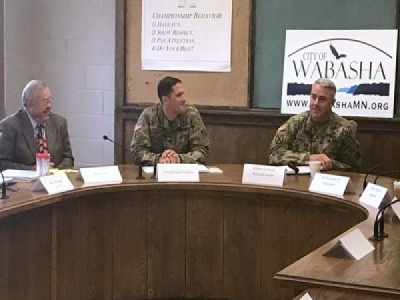
Posted on November 6, 2017
By Brian Todd, Post Bulletin
It looks like plan B is right around the corner.
When the U.S. Army Corps of Engineers in St. Paul announced their initial plan to dispose of nearly 11 million cubic yards of dredge material from Lower Pool 4 over the next 40 years, that plan was met with near universal animosity. From local landowners to the city and county of Wabasha, the plan became public enemy No. 1.
“We, as a city, will have to explore all our options,” said Wabasha City Administrator Chad Springer back in early June. “We would not just lay down by any means.”
Today, the stakeholders in Wabasha are working with the Corps to develop a new plan that will satisfy the city, county, landowners and local businesses. That plan, said Springer, is likely due to be introduced to the public in mid-December.
“I think the Corps is certainly leaning toward a new plan or a revised plan,” Springer said.
In fact, he spent time in St. Paul last week working on that new plan, a version or combination of the alternative plans submitted by stakeholders to the Corps on Oct. 10 after several developmental sessions to find a workable solution to the dredge material problem.
“It’s very satisfying,” he said, commenting on the process that is leading to that new plan. “That being said, there’s still a draft plan on the table we don’t agree with. We ain’t laying down.”
Col. Sam Calkins, commander of the Corps’ St. Paul District, said that as the opposition to the Corps’ plan became apparent and the plan became “difficult to defend,” he and his colleagues began working closely with those stakeholders in Wabasha and across the river in Buffalo County, Wis., to develop that new plan.
“We’re pretty confident we won’t have to purchase farmland or land in direct vicinity to residential property,” Calkins said.
Missed Step
One of the main things the Corps has learned through this process, Calkins said, is the need to bring the local stakeholders in earlier and “make this a community plan, not a Corps of Engineers plan.”
Between the rollout of the plan — sending copies of a 153-page document to unsuspecting landowners — and planning to take their land without first holding one-on-one discussions with those property owners, the Corps got it “drastically wrong,” Calkins said.
The last dredge material management plan was back in the 1980s, he said, when tourism and development in the area were not at the level they are today. Less upland property is available, and fewer folks are willing to sell.
When the backlash against the current plan began, he said, the Corps was a little bit caught off guard by the way locals rallied with their grass-roots efforts, bringing in elected officials to help make their case.
“And we should have done a better job emphasizing it was a draft plan,” he said.
Working Together
The Corps has certainly embraced the concept of developing an alternative to the original draft plan, Springer said. In fact, he described them as a partner in the process now, something he wished every government agency involved with the work on the alternative plans had done. “We’d like to see as an outcome of this that these agencies are more proactive at coming up with outcomes on river issues,” he said.
While the people who live around Lower Pool 4 showed strong opposition to that original plan, Calkins said, they always were respectful of the Corps and always showed a willingness to work for a better solution. In fact, the Corps in St. Paul has looked at how it miscalculated the reception of the plan — both the plan itself and the roll out — and shared that information throughout the Corps to help improve similar processes in the future.
“The people in Wabasha, from the first time I was down there in June at the high school, people were very friendly,” he said. “I talk to (Kellogg farmer Willard Drysdale) and his daughter before the event. They were upset, but very friendly to me.”
It was at that meeting and a dialogue hosted by the Post Bulletin, Calkins said, where he realized the mistakes the Corps has made and the need to make changes.
“It hit me there for the first time,” the colonel said. It was there he apologized to Drysdale and Jason Weisenbeck, a farmer from Nelson, Wis., and apologized for the way the plan was rolled out. “The more you put yourself in their shoes, the plan is pretty difficult to defend.”
Meet First, Plan Second
Moving forward, Calkins said, the Corps plans to work with stakeholders first, before rolling out a draft plan. That will help get the public onboard because they’ve had a more direct say in developing the plan, much like the new plan the Corps will likely roll out in December for Lower Pool 4.
“It’ll have stakeholder buy-in for sure,” he said. “We’ll be announcing it to the public for the first time, but landowners will be well aware of the plan.”
Springer said the city brought several alternate options to the Corps on Oct. 10, and one idea in particular — he would not name which one yet — has received the most attention.
“They have grabbed this preferred alternative by the horns, and are working behind the scenes,” he said. “Now, we’re waiting on December. That’s the date when a new plan would be presented and that’d be a win for the city.”
Source: Post Bulletin





